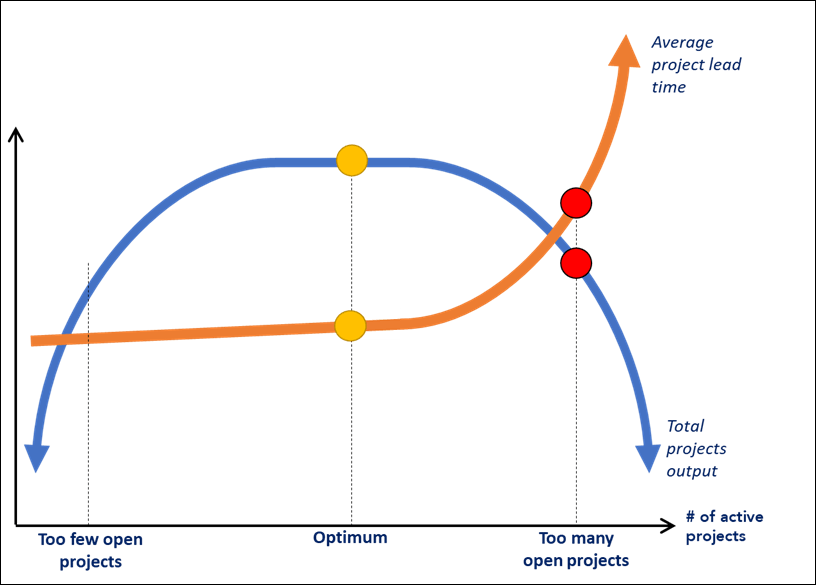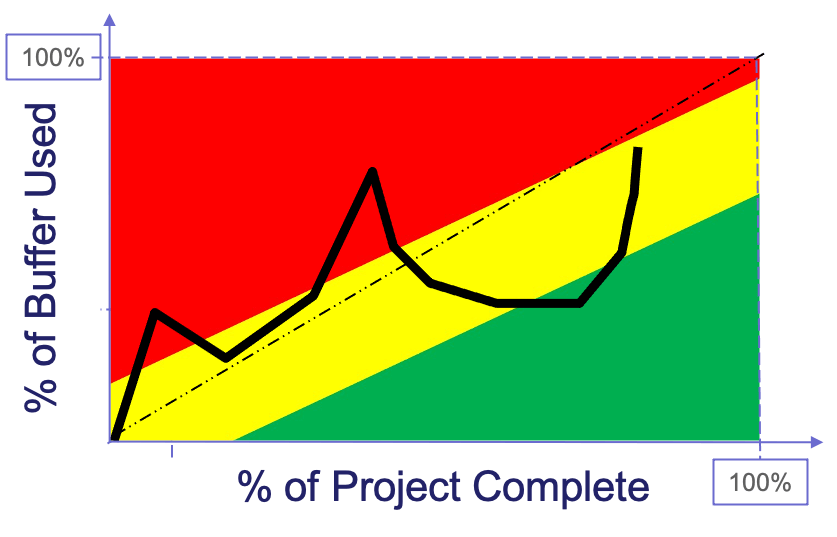How to reduce stress and improve output with Project Portfolio FLOW.
People in project organisations never experience a dull moment:
- Finish dates of projects are uncertain and must again and again be delayed
- Too many projects compete for attention
- Critical input from clients and suppliers is often overdue and repeatedly necessitates rework
‘Never a dull moment’ is an understatement. In fact, people in project organisations are often stressed out.

This would be less of an issue when all that stress would be rewarded with results. However, this is not the case, stress in multi project environments always is a good indicator of underperformance.

The figure to the right shows that there is an optimum in the number of active projects. This optimum corresponds with short project lead times and maximum project output. Imagine for a while how fast a single project could be completed if it would be staffed with the right (number of) people, if it would be supported by management whenever needed and if the project would never have to wait for input from clients and suppliers. These conditions describe the optimum – golden dots – for a multi project environment. Beyond the optimum ever more projects are being worked on, increasing ‘Work in Progress’ for everybody. People start switching between open tasks in many different projects, multiplying the time they need to complete their tasks. Also, due to the amount of task switching, more mistakes will be made. Every mistake needs to be corrected, adding even more project lead time. In conclusion, beyond the optimum, adding more projects will result in less project output.
If the vicious cycle, as described above, is the reality in your project organisation, it will lead to increased project lead times and lower projects output. This is the meaning of being on the red dots in the above figure: People overloaded with work congest the project highway, which leads to lower productivity and financial underperformance.
Let us do a simple test. Do people in your organisation regularly ask leadership for project priorities? A “yes” is a sure sign that people´s attention is diverted over too many projects: your company is on the red dots. If so, please read on, you may find the solution to your problem in this article.
Detailed scheduling will not help you
Nearly always, when we ask clients how often schedules turn out as planned, people react with a smile. Even though this already says everything, many still try to control reality by making people accountable for their part of the work with strict time limits. They even double down on these efforts when work delays.
 Now, no one can predict the future. This becomes clear when you consider what you would answer to the question how long it takes to travel from home to work. Most probably you won´t come up with a fixed time estimate, but with a time span accounting for different types of traffic conditions. But then at work, we expect people to give fixed time estimates for a whole series of activities with much higher uncertainty! As if they can predict the future…
Now, no one can predict the future. This becomes clear when you consider what you would answer to the question how long it takes to travel from home to work. Most probably you won´t come up with a fixed time estimate, but with a time span accounting for different types of traffic conditions. But then at work, we expect people to give fixed time estimates for a whole series of activities with much higher uncertainty! As if they can predict the future…
Schedules are a wonderful way to prepare for the future
Does this mean that we should stop planning, as Agile gurus claim? Certainly not! One of the most important rules of FLOW is focus, which means that people know what to work on and what not to work on. We need planning to enable that. Good planning gives us clear task level priorities. These priorities give people guidance on what they should be focusing on now. This focus alone will already make a tremendous improvement to the time people need for their tasks.
How do we make sure that schedules create FLOW in project execution? In our view there are three crucial parts to that:
 We start with accepting that estimates are just what they are: estimates. We cannot hold people accountable for meeting an uncertain estimate, unless we accept the consequence that estimates will contain safety. Therefor we use a significant part of the estimates and aggregate that safety into a project buffer. A buffer people can make use of when needed, and where they give back to when they finish tasks earlier than estimated.
We start with accepting that estimates are just what they are: estimates. We cannot hold people accountable for meeting an uncertain estimate, unless we accept the consequence that estimates will contain safety. Therefor we use a significant part of the estimates and aggregate that safety into a project buffer. A buffer people can make use of when needed, and where they give back to when they finish tasks earlier than estimated. We may not be able to hold people accountable for meeting their fixed estimates, but we can hold people accountable for performing their tasks first time right and as swift as reasonably possible. We call this: Project execution according to the Relay Race ethic.
We may not be able to hold people accountable for meeting their fixed estimates, but we can hold people accountable for performing their tasks first time right and as swift as reasonably possible. We call this: Project execution according to the Relay Race ethic. Another crucial, but difficult step is needed.: Don’t load more projects into the organisation, then your organisation can handle. This way you make sure that once a project is activated, it will flow like it is the only active project. Much faster than you would ever have believed possible, with better quality and happy people. Of course, also the projects in the backlog will be finished earlier than before, if each project is executed in the fastest possible way.
Another crucial, but difficult step is needed.: Don’t load more projects into the organisation, then your organisation can handle. This way you make sure that once a project is activated, it will flow like it is the only active project. Much faster than you would ever have believed possible, with better quality and happy people. Of course, also the projects in the backlog will be finished earlier than before, if each project is executed in the fastest possible way.
The ‘traffic jam’ has turned into a flowing project highway! Your organisation moved from the ‘red dots’, to the ‘golden dots’.
How to adopt the Project Portfolio FLOW solution?
Project Portfolio FLOW is part of a leadership philosophy that facilitates professionals with sensible and pragmatic instruments. These instruments motivate professionals by enabling them to perform to the best of their possibilities and achieve a FLOW state of mind. Project Portfolio FLOW draws on the works of great management thinkers like Peter Drucker, Mihaly Csikszentmihalyi and Eli Goldratt.
You are obviously not the first to apply Project Portfolio FLOW. Among the companies that successfully implemented these principles are household names like: Airbus, Boeing, Bosch, SAP and Rio Tinto, just to name a few.
All good things go by three. It is one thing to explain FLOW. It is another thing to make it work in your organisation, to synchronize your project organisation for FLOW and to train and motivate your people to work with FLOW.
And as concerns the saying “all good things go by three”: If you think this story could apply to your organisation, the third good thing would be to contact us today. We are happy to learn about your experiences and to examine how your organisation could prepare for better results.
Feel free to send us an email or schedule a strategy call.
© 2021 Mobilé 4 flow & innovation, all rights reserved

Menno has seen it all, from Agile to Lean, and he brings everything together on a strategic level in Projects Portfolio FLOW.

 We start with accepting that estimates are just what they are: estimates. We cannot hold people accountable for meeting an uncertain estimate, unless we accept the consequence that estimates will contain safety. Therefor we use a significant part of the estimates and aggregate that safety into a project buffer. A buffer people can make use of when needed, and where they give back to when they finish tasks earlier than estimated.
We start with accepting that estimates are just what they are: estimates. We cannot hold people accountable for meeting an uncertain estimate, unless we accept the consequence that estimates will contain safety. Therefor we use a significant part of the estimates and aggregate that safety into a project buffer. A buffer people can make use of when needed, and where they give back to when they finish tasks earlier than estimated. We may not be able to hold people accountable for meeting their fixed estimates, but we can hold people accountable for performing their tasks first time right and as swift as reasonably possible. We call this: Project execution according to the Relay Race ethic.
We may not be able to hold people accountable for meeting their fixed estimates, but we can hold people accountable for performing their tasks first time right and as swift as reasonably possible. We call this: Project execution according to the Relay Race ethic. Another crucial, but difficult step is needed.: Don’t load more projects into the organisation, then your organisation can handle. This way you make sure that once a project is activated, it will flow like it is the only active project. Much faster than you would ever have believed possible, with better quality and happy people. Of course, also the projects in the backlog will be finished earlier than before, if each project is executed in the fastest possible way.
Another crucial, but difficult step is needed.: Don’t load more projects into the organisation, then your organisation can handle. This way you make sure that once a project is activated, it will flow like it is the only active project. Much faster than you would ever have believed possible, with better quality and happy people. Of course, also the projects in the backlog will be finished earlier than before, if each project is executed in the fastest possible way.